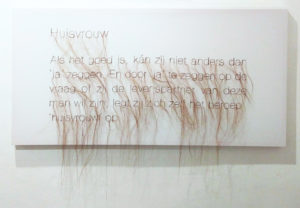Huisvrouw (Housewife)
From the series: Apolline, Constance et les autres …
Elyse Galiano
2014-2018
Natural hair, cotton canvas, wood
60 cm x 120 cm
In her series “Apolline, Constance et les autres …” Elyse Galiano embroidered texts from ancient manuals of good manners for women. The most part of the quotes dates from the late 18th, 19th and 20th century, when these handbooks were common in whole Europe. It was a kind of advice to educate young girls and prepare them for their future as wife and mother.
“Huisvrouw” (Housewife) is remarkable, because the text was published only in 1971, so it is more recent than the others. Its original language is Flemish and describes the consequences of marriage for women.
Huisvrouw
Als het goed is, kan zij niet anders dan ‘ja’ zeggen. En door ‚ja‘ te zeggen op de vraag of zij de levenspartner van deze man wil zijn, legt zij zich zelf het beroep ‚huisvrouw‘ op.
(Anna M. J. Van Deinse: Levenskunst, 1971)
Translation:
Housewife
If all is correct, she cannot say anything other than ‘yes’. And by saying ‘yes’ to the question whether she wants to be the partner of this man, she puts herself up the profession ‘housewife’.
Elyse stitched the letters with natural hair on the canvas. Besides bearing children and leading the household, textile handicrafts was for centuries the common occupation of upper class woman. In consequence, the chosen technique refers to a genuine female activity. Moreover, the artist used natural hair. For a work like “Housewife”, she needs long hair. It was and is in different cultures an expression for femininity: dressed up it might be a status symbol, hidden it signifies chastity and virtue.
The diligent embroidered hair in “Housewife” doesn’t seem to be so modest. As Samanta Crunelle remarked, the strands appear as if they want to escape. It looks like they are growing out of the text, indomitable and rebellious. This stands in sharp contrast to the claim of the stitched text, which states, that – in best case – the housewife can’t oppose. With her first approval to a common life with a man, she accepted this principal. Moreover, she recognises her role and destiny.
Nearly a half century passed since the publication of the Flemish text. Within this time, women fought for their emancipation, like the hair in Elyse’s oeuvre wants to free itself. In western and other societies, equal rights are now guaranteed by the constitution. Nevertheless, even nowadays, women often handle the bigger part of the domestic management and work. The current #MeToo-debate reveals abysses. On first glance, Elyse’s work seems to be an ironic comment on past education advices for women. Actually, she is pointing on still existing old structures.
Elyse Galiano
Born in 1980 in Strasbourg, France, Elyse lives and works in Brussels, Belgium. After her education in applied arts in Strasbourg, she studied fine arts in Besançon, France, which she completed with the diploma DNSEP (level Master) in 2004. To extend her practical skills, she entered in the Atelier de Couture (tailoring studio) of Caroline in Ixelles, Belgium. During her studies, the artist frequented internships and artist residences. In particular, she made work placements at the Nouveau Théâtre in Besançon and the Opéra la Monnaie in Brussels, where she still occasionally assists in the making of decors and costumes.
These activities were guiding for Elyse’s artistic practice. Often, her installations evoke stage designs, where fabric plays an important role. Concurrently, she works as scenographer and costume designer for several theatres like the Théâtre de la Guimbarde, Charleroi, Belgium and the Lily & Compagnie, Tournai, Belgium. Her experience in tailoring are a good base for these tasks. Since 2006 arises a passion for embroidery, which is reflected in her creative outcome. Thereby, the thread is increasingly replaced by natural hair, like in our artwork of the month of March 2018.
Beyond that, Elyse processes natural hair and resembling materials in sculptural installations, like the series “de corps et d’esprit” and “de l’intime”. For monumental installations like “orphélia” or “macrale” she uses brass wire. Going along with the integration of hair, is an interest in the female history and the women’s place in society. An expression for this research, are the works in the artist’s first solo exhibition “Apolline, Constance et les autres…” (Spazio Testoni, Bologna, 25 November 2017 – 13 January 2018). There was the embroidery of the title giving series, the display portraits in natural hair (de corps et d’esprit), a brass wire installation and one room dedicated to female handiwork (ouvrage de dames). Like for the canvas hair embroidery, Elyse stitched texts from ancient manuals for female manners. Nevertheless, this time the dimensions are limited to handkerchiefs and the stitching is by “normal” threads.
Due to her experience of different cultural influences, the sources of the texts are in several European languages. Grown up in the Alsace, a French frontier region with Germanic influences, the artist lives since eight years in Brussels. Besides the three official Belgian languages (French, Flemish and German) English is also present, as the city is seat of the European Parliament. Additionally, Elyse introduced Italian into her works, since this is the language of the exhibition hosting country.
She participated with her sculptural oeuvre and installations in many group shows, mainly in France and in Belgium. Also, she created decors for festivals. Besides her activity as scenographer and costume designer, she gives workshops in embroidery (currently ACT, Brussels, but soon in her own atelier) and intervenes in schools (Mus-e asbl, Bruxelles). At the moment, Elyse prepares the next exhibition at the gallery C2 Contemporanea 2 in Florence, Italy, which will open at 12 April 2018.

